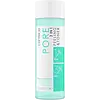What's inside
What's inside
 Key Ingredients
Key Ingredients

 Benefits
Benefits

 Concerns
Concerns

 Ingredients Side-by-side
Ingredients Side-by-side

Water
Skin ConditioningGlycerin
HumectantMandelic Acid
AntimicrobialButylene Glycol
HumectantCamellia Sinensis Leaf Extract
AntimicrobialSalicylic Acid
MaskingEnantia Chlorantha Bark Extract
Skin ConditioningTocopherol
AntioxidantAllantoin
Skin ConditioningEthylhexylglycerin
Skin ConditioningOleanolic Acid
Skin ConditioningSodium Hydroxide
BufferingCitric Acid
BufferingPhenoxyethanol
PreservativeSodium Benzoate
MaskingPotassium Sorbate
PreservativeEthylhexyl Palmitate
EmollientPrunus Amygdalus Dulcis Oil
Skin ConditioningSilica Dimethyl Silylate
EmollientSimmondsia Chinensis Seed Oil
EmollientArgania Spinosa Kernel Oil
EmollientTocopherol
AntioxidantRosa Moschata Seed Oil
EmollientSynthetic Fluorphlogopite
Tocopheryl Acetate
AntioxidantLecithin
EmollientSilica
AbrasiveMica
Cosmetic ColorantAscorbyl Palmitate
AntioxidantTin Oxide
AbrasiveCitric Acid
BufferingAroma
CI 77491
Cosmetic ColorantCI 77891
Cosmetic ColorantEthylhexyl Palmitate, Prunus Amygdalus Dulcis Oil, Silica Dimethyl Silylate, Simmondsia Chinensis Seed Oil, Argania Spinosa Kernel Oil, Tocopherol, Rosa Moschata Seed Oil, Synthetic Fluorphlogopite, Tocopheryl Acetate, Lecithin, Silica, Mica, Ascorbyl Palmitate, Tin Oxide, Citric Acid, Aroma, CI 77491, CI 77891
 Reviews
Reviews

Ingredients Explained
These ingredients are found in both products.
Ingredients higher up in an ingredient list are typically present in a larger amount.
Citric Acid is an alpha hydroxy acid (AHA) naturally found in citrus fruits like oranges, lemons, and limes.
Like other AHAs, citric acid can exfoliate skin by breaking down the bonds that hold dead skin cells together. This helps reveal smoother and brighter skin underneath.
However, this exfoliating effect only happens at high concentrations (20%) which can be hard to find in cosmetic products.
Due to this, citric acid is usually included in small amounts as a pH adjuster. This helps keep products slightly more acidic and compatible with skin's natural pH.
In skincare formulas, citric acid can:
While it can provide some skin benefits, research shows lactic acid and glycolic acid are generally more effective and less irritating exfoliants.
Most citric acid used in skincare today is made by fermenting sugars (usually from molasses). This synthetic version is identical to the natural citrus form but easier to stabilize and use in formulations.
Read more about some other popular AHA's here:
Learn more about Citric AcidTocopherol (also known as Vitamin E) is a common antioxidant used to help protect the skin from free-radicals and strengthen the skin barrier. It's also fat soluble - this means our skin is great at absorbing it.
Vitamin E also helps keep your natural skin lipids healthy. Your lipid skin barrier naturally consists of lipids, ceramides, and fatty acids. Vitamin E offers extra protection for your skin’s lipid barrier, keeping your skin healthy and nourished.
Another benefit is a bit of UV protection. Vitamin E helps reduce the damage caused by UVB rays. (It should not replace your sunscreen). Combining it with Vitamin C can decrease sunburned cells and hyperpigmentation after UV exposure.
You might have noticed Vitamin E + C often paired together. This is because it is great at stabilizing Vitamin C. Using the two together helps increase the effectiveness of both ingredients.
There are often claims that Vitamin E can reduce/prevent scarring, but these claims haven't been confirmed by scientific research.
Learn more about Tocopherol